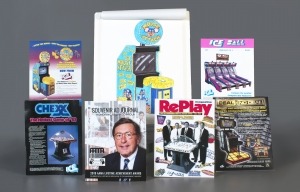Tuesday, February 23, 2021
For Immediate Release
Shane Rhinewald, 585-410-6365, srhinewald@museumofplay.org
ROCHESTER, NY—The Strong, home to the World Video Game Hall of Fame, has received a donation from the family of Buffalo-native Ralph Coppola (1948–2018), president of the coin-operated game developer and manufacturer Innovative Concepts in Entertainment (ICE) and manufacturer of the iconic Chexx (1982) “bubble hockey” game. The donated materials include design documentation, concept artwork, correspondence, photographs, magazines, fliers, and catalogs related to Coppola and the games his company produced.
“These materials document nearly 40 years of a local company—headquartered only about 60 miles from  The Strong in Buffalo, New York—that Ralph Coppola built into an international, coin-operated game industry leader,” says Jeremy Saucier, assistant vice president for interpretation and electronic games. “Coppola was a creative force in the coin-operated industry and led the development and release of more than 150 arcade games. His company’s Chexx game, often referred to as ‘bubble hockey,’ became an arcade and amusement industry icon.”
The Strong in Buffalo, New York—that Ralph Coppola built into an international, coin-operated game industry leader,” says Jeremy Saucier, assistant vice president for interpretation and electronic games. “Coppola was a creative force in the coin-operated industry and led the development and release of more than 150 arcade games. His company’s Chexx game, often referred to as ‘bubble hockey,’ became an arcade and amusement industry icon.”
Coppola and partner Jack Willert incorporated ICE in 1982. While perhaps best known for Chexx and later Super Chexx, the company’s 1995 light tracking game Cyclone became one of the most popular and highest-earning redemption games of all time. Throughout its nearly 40-year history, the company has developed all manner of redemption games, sports games, air hockey tables, alley bowlers, coin pushers, skill cranes, merchandisers, and video games. The donation includes more than 200 pieces of game design and engineering documentation from the 1980s through 2000s, including conceptual drawings of cabinets and cabinet graphics for games such as Full Court Fever (1995), Mouse Attack (1996), Deal or No Deal (2007), 2 Minute Drill (2008), and Buster Bubbles (2009), as well as oversized engineering drawings for games such as Chexx and Cyclone (1995).
“When The Strong contacted us regarding preserving early artifacts, blueprints, and documents pertaining to our father, Ralph Coppola & Innovative Concepts in Entertainment (ICE), we were honored to be able to donate some original materials from the early days of ICE. Interestingly, the company is still manufacturing the game, SUPER CHEXX, which was the original coin-operated bubble hockey game developed and designed back in the early 1980’s. We are hopeful that some of the early materials provided will be resourceful for those studying and interested in the coin-operated amusement industry, especially as this was one of the first great competitive electro-mechanical games ever made,” says Daniel Coppola, vice president, ICE. “We are elated that this story—our father’s story—will live on and be a part of his legacy. No doubt he never envisioned in those early days of designing Chexx in the small garage of a home in Buffalo that ICE would become a global leader in the arcade industry. It is an honor to the entire Coppola and extended ICE families to have our history be a part of The Strong.”
Coppola built such a strong reputation in the industry that following his death in 2018 the American Amusement Machine Association honored him with its lifetime achievement award. His materials will enhance The Strong’s collection of coin-operated materials, including the Atari Coin-op Divisions Collection, and be valuable to researchers interested in coin-op redemption game development and manufacturing. The materials will also be included in future displays at The Strong on the subject.
About The Strong
The Strong is the only collections-based museum in the world devoted solely to the history and exploration of play. It is home to the International Center for the History of Electronic Games, the National Toy Hall of Fame, the World Video Game Hall of Fame, the Brian Sutton-Smith Library and Archives of Play, the Woodbury School, and the American Journal of Play and houses the world’s largest and most comprehensive collection of historical materials related to play.



